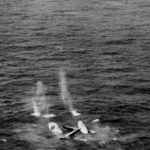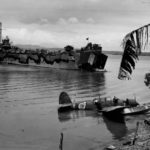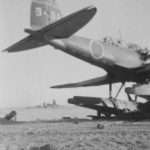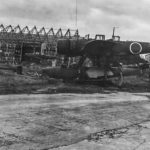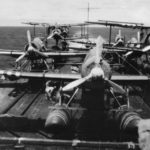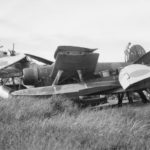E13A Jake Kyushu 1945
E13A Aleutians 1942
E13A of Kashima Naval Air Group
E13A Jake Sinking off Formosa 1944
Wreckof E13A Jake on Saipan July 1944
E13A and USS LST-806 Palawan, Philippines 1945
Captured E13A Yo-31 of the Yokosuka Kokutai, 1945
Captured E13A Yo-31 of the Yokosuka Kokutai, 1945 2
E13A from Kamikawa Maru 1942
VPB-117 PB4Y1 Shooting Down an E13A 1944
E13A Palawan Philippines 1945
E13A Palawan 1945
E13A1b Jake of the 901st Kokutai uner attack Formosa 1944
E13A floatplanes at Tatayama Air Base 1945
Dummy E13A Balikpapan July 1945
E13A floatplanes
Aichi E13A aboard cruiser Mogami 1943
E13A floatplanes at Seletar airfield 1945
The E13A is a seaplane scout aircraft developed by Aichi Aircraft Co. Allies gave it the code name Jake.
In 1937, the Imperial Japanese Navy instructed Kawanishi Aircraft Works and Aichi Aircraft to develop a successor to the Type 94 seaplane reconnaissance aircraft, the Tri-Seated Seaplane Recon. The Navy’s requirement was for a long-range reconnaissance aircraft that could be operated both on shipboard and from a seabase, with a maximum speed of 370 km/h. The prototype was completed in 1938. The prototype was not delivered until September 1938, but Aichi had too much work to do on other prototypes and improvements, so it was rejected in time. However, Aichi Aircraft continued to manufacture the aircraft for use as research material, and the first aircraft was completed in January 1939. The fuselage was made of metal (the wing tips were made of wood), and it was a low-wing, monoplane, twin-floating seaplane with folding wings and simple flaps. The engine power and armament were both more powerful than the Type 94, especially the bomb bay in the fuselage, which could carry two small bombs.
In June 1939, the Kawanishi-made aircraft was lost in an accident, so the Navy hurriedly received an Aichi-made aircraft and tested it at Yokosuka. As a result, it was decided to adopt it because of its excellent flight performance, and it was officially adopted in December 1940. The IJN had been preparing to equip early aircraft carriers, battleships, cruisers and submarines with seaplane reconnaissance aircraft, and to operate them as the key to reconnaissance. The deployment of these aircraft was the finishing touch to this process, which began in earnest in 1941 with the deployment of the aircraft on ships and bases. At the outbreak of the Pacific War, the aircraft were on board the main ships of the Navy and were actively used as the eyes of the fleet and bases in the overseas territories.
The early stages of the war were reasonably successful, but from 1943 onwards it became difficult to obtain detailed information on the enemy fleet and bases, which were well equipped with carrier-based aircraft and interceptor fighters, mainly due to the lack of speed and acceleration characteristic of seaplanes. For this reason, the reconnaissance mission gradually shifted to ship-based aircraft. In addition, the “Saiun” was also developed as a reconnaissance aircraft carried on the ship. For aircraft carriers that wanted to maximise their offensive power while having a limited number of aircraft on board, a specialised reconnaissance aircraft was unique. However, because the aircraft could be operated from battleships and cruisers accompanying the carrier to reduce the burden on the on-board reconnaissance aircraft, and because its three-seat configuration allowed it to be used as a night reconnaissance aircraft, the role of the seaplane reconnaissance aircraft did not diminish in the second half of the war. (For example, it was a bomb from one of these aircraft that sunk the submarine USS Wahoo as it fled through the Soya Strait on 11 October 1943).
A small number of the aircraft were also supplied to Thailand, then a friendly country. At the end of the Second World War there were about 200 of these aircraft left, of which about a quarter were still in the field. A few were later handed over to the French, who used them in their Indochina colonies. In Japan, the aircraft raised from the sea are on display and preserved at the Bansei Kamikaze Peace Memorial Museum in Minami-Satsuma, Kagoshima Prefecture.
The aircraft was manufactured at Aichi Aircraft, Watanabe Ironworks (later Kyushu Aircraft) and the Hiro Naval Arsenal. The total number of aircraft produced was 1,423, of which only 133, or less than 10%, were built at Aichi, most of them at Watanabe Ironworks. In fact, in addition to the Model 11 E13A1, which is the basic type, there were other models such as the Model 11 A E13A1a, which was equipped with a Type 3 Air No. 6 Wireless Telegraph Type 4, and the Model 11 B E13A1b, which was equipped with a Type 3 Type 1 Detector in addition to the Model 11 A, and a flame dumper in the exhaust pipe for searching submarines.



